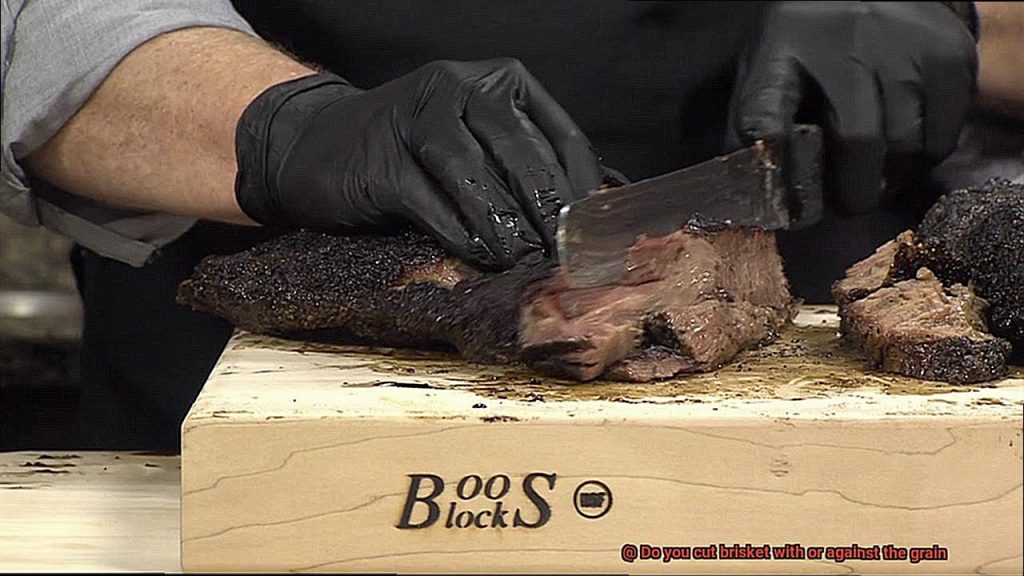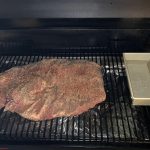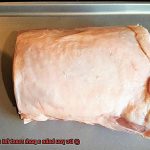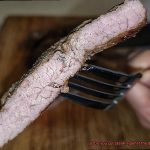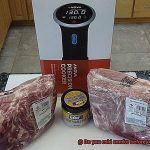Are you ready to take your brisket game to the next level? As a BBQ enthusiast or meat lover, you know that brisket can be one of the most challenging cuts of meat to perfect. From selecting the right cut to seasoning and cooking low and slow, every detail counts. But there’s one crucial step that often gets overlooked: how to slice your brisket.
The age-old question remains: should you cut brisket with or against the grain? It might seem like a minor detail, but it can significantly impact the final taste and texture of your dish. Cutting with the grain results in long, stringy pieces that can be tough to chew, while cutting against the grain makes for tender and juicy beef.
In this blog post, we’ll delve into the art of slicing brisket. We’ll explain what “the grain” means, demonstrate how to identify it, and guide you through the steps to correctly slice a brisket. We’ll also explore why cutting against the grain is scientifically proven to be superior and share insider tips on how to achieve mouth-watering results. By the end of this article, you’ll have all the knowledge and confidence needed to serve up an unforgettable brisket feast.
Contents
What is the Grain?
In simple terms, the grain refers to the direction in which the muscle fibers of the meat run. The texture and tenderness of the meat are determined by these fibers.
When you slice against the grain, you cut perpendicular to the muscle fibers, shortening them and making the meat easier to chew. Conversely, slicing with the grain means cutting along the muscle fibers, possibly resulting in tougher and chewier meat.
Identifying the grain can be challenging, particularly if the meat has been trimmed or cooked for an extended period. However, there are some tips to help identify it. Look for lines or striations on the meat or gently pull on it to see which way the fibers are running.
Understanding the grain is crucial when preparing brisket as it is a tough cut that requires extra care and attention. Cutting against the grain ensures tenderness and maximum flavor.
Cutting with the Grain
It’s time to master the art of cutting against the grain. Trust us, it’s a game-changer.
Let’s start by discussing what we mean by “the grain.” The grain refers to the lines of muscle fibers in the meat that can be seen running parallel to each other. When you cut with the grain, you are essentially leaving those long muscle fibers intact. This can result in a less-than-ideal eating experience, as the meat can be tough and chewy.
But fear not. Cutting against the grain is the solution. By slicing across those muscle fibers, you are essentially breaking them up and making the meat more tender. This is especially important for brisket, which is a tough cut of meat that requires slow cooking methods to break down its connective tissues.
To determine which way the grain is running in your brisket, look for those visible lines on the surface of the meat. Once you’ve identified which direction the grain is running, use a sharp knife to slice across those lines at a slight angle. This will ensure that you’re cutting against the grain and breaking up those tough muscle fibers.
Now, there are times when cutting with the grain may be beneficial – think bacon or deli meats. But for brisket, cutting against the grain is key to achieving that mouth-watering tenderness that we all crave.
Cutting Against the Grain
This cooking technique is the key to unlocking a tender and juicy brisket that will have your taste buds singing.
Why is cutting against the grain so important? Let’s break it down:
- Breaking Down Tough Muscle Fibers: Brisket is notorious for its tough texture, but slicing against the grain helps to break down those pesky muscle fibers into smaller pieces. This means less work for your teeth and a more enjoyable eating experience.
- Creating Shorter Muscle Fibers: When you slice against the grain, you create shorter muscle fibers that are easier to digest. No more feeling like you’re chewing on rubber bands.
- Avoiding Chewy Texture: Cutting with the grain can result in long muscle fibers that are stringy and chewy. By cutting against the grain, you avoid this unpleasant texture and create a melt-in-your-mouth experience.
Now that you know why cutting against the grain is so important, how do you do it? First, identify which direction the muscle fibers are running by examining the meat from different angles. Then, use a sharp knife to slice perpendicular to those lines.
But beware – cutting against the grain can be tricky if your knife isn’t sharp enough. To avoid shredding or tearing the meat, make sure your knife is sharp before you start slicing.
The Benefits of Cutting Against the Grain
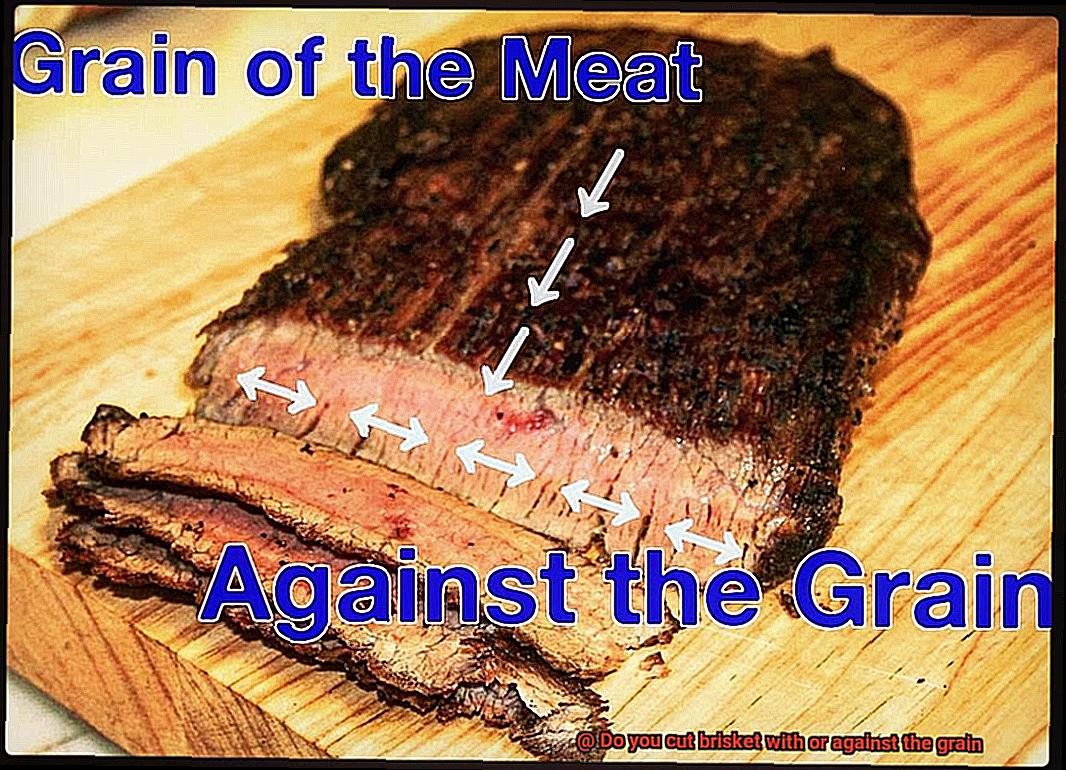
Cutting against the grain is not just about aesthetics, it is an essential technique that maintains the tenderness and juiciness of your meat. When cooked, the muscle fibers contract and become denser, making it harder to chew and digest. However, by slicing perpendicular to the muscle fibers, you break down these tough muscle fibers and create shorter, easily digestible fibers.
This results in a melt-in-your-mouth experience that will leave your guests wanting more.
But there’s more. Cutting against the grain also enhances the texture of the meat. By creating smaller pieces that are easier to bite and chew, you guarantee each bite contains a consistent texture and tenderness, making for a more enjoyable eating experience.
And let’s not forget about flavor. When you slice against the grain, you retain the natural juices in the meat which means each bite is packed with flavor and moisture.
If that’s not enough, cutting against the grain allows for more even cooking. With uniform sizes, each piece cooks evenly and retains its moisture, resulting in a perfectly cooked meal every time. No more overcooked or undercooked pieces.
How to Cut Brisket Against the Grain
Cutting brisket against the grain is a skill that can elevate your barbecue game to the next level. It’s not just about aesthetics; it’s about maximizing the tenderness and flavor of the meat. Here are five steps to help you master this technique:
Step 1: Identify the grain.
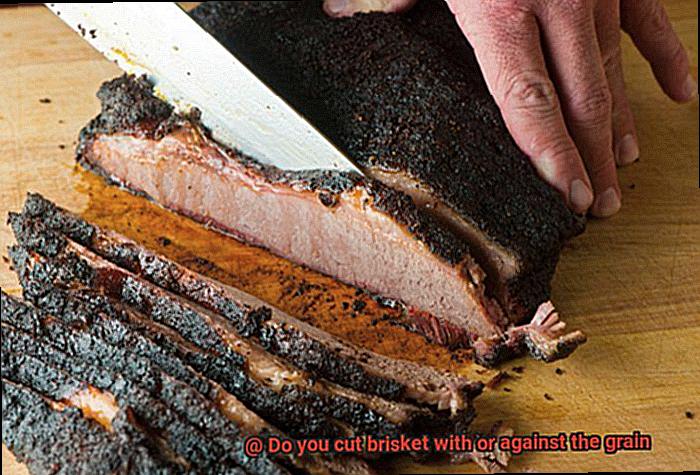
The grain refers to the direction in which the muscle fibers run. Look for the long lines or striations that run across the meat. You want to cut perpendicular to those lines, which will shorten the muscle fibers and make them easier to chew.
Step 2: Use a sharp knife.
A dull knife will tear the meat instead of slicing it cleanly. Make sure your knife is sharp, and consider honing it before each use.
Step 3: Slice against the grain.
Once you’ve identified the direction of the grain, use a gentle sawing motion to slice across it in thin slices. It’s important to cut against the grain for each slice, so adjust your angle as needed.
Step 4: Angle your knife.
Hold your knife at a slight angle while you slice, which will create wider slices and expose more surface area of the meat. This will help you taste more of its rich flavor.
Step 5: Practice makes perfect.
Cutting brisket against the grain can be challenging at first, but with practice and patience, you’ll get better over time. Don’t worry if your first few slices aren’t perfect – keep practicing, and you’ll soon be cutting brisket like a pro.
Tips for Preparing Brisket
Brisket is one of the most popular cuts of meat for smoking or grilling, but it can be a challenging task to cook it perfectly. However, with a few expert tips and tricks, you can prepare a delicious brisket that will leave your guests wanting more.
Here are some tips to keep in mind when preparing brisket:
Trim the Fat
Trimming the fat is an important step in preparing brisket. Excess fat can make the meat greasy and tough. By trimming the fat, you help ensure that the meat cooks evenly and retains its natural flavors.
Season Generously
Seasoning is essential for adding flavor and tenderizing the meat. A simple rub of salt, pepper, and garlic powder is a classic seasoning that can be used on brisket. But you can also experiment with other spices and herbs for added flavor.
Cut Against the Grain
When it comes to slicing your brisket, cutting against the grain is crucial to ensuring that it comes out tender and juicy. The grain refers to the direction of the muscle fibers in the meat. To find out which way they run, look for the lines in the meat fibers and cut perpendicular to them.
Cook Low and Slow
Cooking brisket low and slow is one of the best ways to break down the tough fibers in the meat and make it tender. You can smoke or grill your brisket at low temperatures for several hours to achieve this result.
Let it Rest
After cooking your brisket, it’s important to let it rest for at least 15-30 minutes before slicing or serving. This allows the juices to redistribute throughout the meat, making it more flavorful and juicy.
Common Mistakes When Cutting Brisket
Smoking or grilling a brisket to perfection is an art form, but the task isn’t complete without slicing it up just right. Cutting brisket is not as simple as it seems, and there are common mistakes that can ruin even the most expertly cooked brisket. As an experienced professional in this field, I’m here to guide you on what NOT to do when cutting brisket.
To start, always remember to cut against the grain. Cutting with the grain will result in a tough and chewy brisket that no one wants to eat. To avoid this mistake, take a close look at your brisket before slicing and make sure you’re cutting perpendicular to those lines or striations in the meat.
Using a dull knife is another common mistake that can ruin your beautifully smoked or grilled brisket. A dull knife tears the meat and results in uneven slices. Invest in a sharp carving knife or an electric knife to make slicing through that juicy brisket effortless.
Don’t skip the resting period. It might seem like an eternity to wait for 10-15 minutes before cutting into that delicious brisket, but trust me, it’s worth it. Allowing the meat to rest allows the juices to redistribute throughout the meat, making it more tender and flavorful. Skipping this step could result in a dry and less tasty brisket.
Not knowing where to find the grain is another common mistake people make when cutting their brisket. Don’t just start slicing willy-nilly; take a moment to locate those muscle fibers and plan out your cuts accordingly.
In conclusion, cutting brisket may seem like an easy task, but there are common mistakes that can ruin all your hard work. Here’s a summary of what to avoid when cutting your brisket:
- Cutting with the grain
- Using a dull knife
- Skipping the resting period
- Not knowing where to find the grain
_xtcOjDnu50″ >
Conclusion
Brisket is the holy grail of BBQ, and every detail counts, from selecting the right cut to cooking low and slow. But one crucial step that often gets overlooked is slicing the brisket. The age-old question remains: should you cut brisket with or against the grain? While it may seem like a minor detail, it can significantly impact the final taste and texture of your dish.
Scientifically proven to be superior, cutting against the grain results in tender and juicy beef. The grain refers to the direction in which the muscle fibers of the meat run. Slicing against the grain cuts perpendicular to these fibers, shortening them and making the meat easier to chew. On the other hand, slicing with the grain means cutting along these fibers, possibly resulting in tougher and chewier meat.
Identifying the grain can be challenging, especially if you’ve trimmed or cooked your meat for an extended period. However, understanding this crucial aspect is essential when preparing brisket as it’s a tough cut that requires extra care and attention.
By mastering this technique, you can take your barbecue game to another level. Cutting brisket against the grain isn’t just about aesthetics; it’s about maximizing tenderness and flavor while enhancing texture and ensuring even cooking. Remember always to use a sharp knife while slicing thin pieces of meat perpendicular to those lines or striations in the meat for mouth-watering results.

